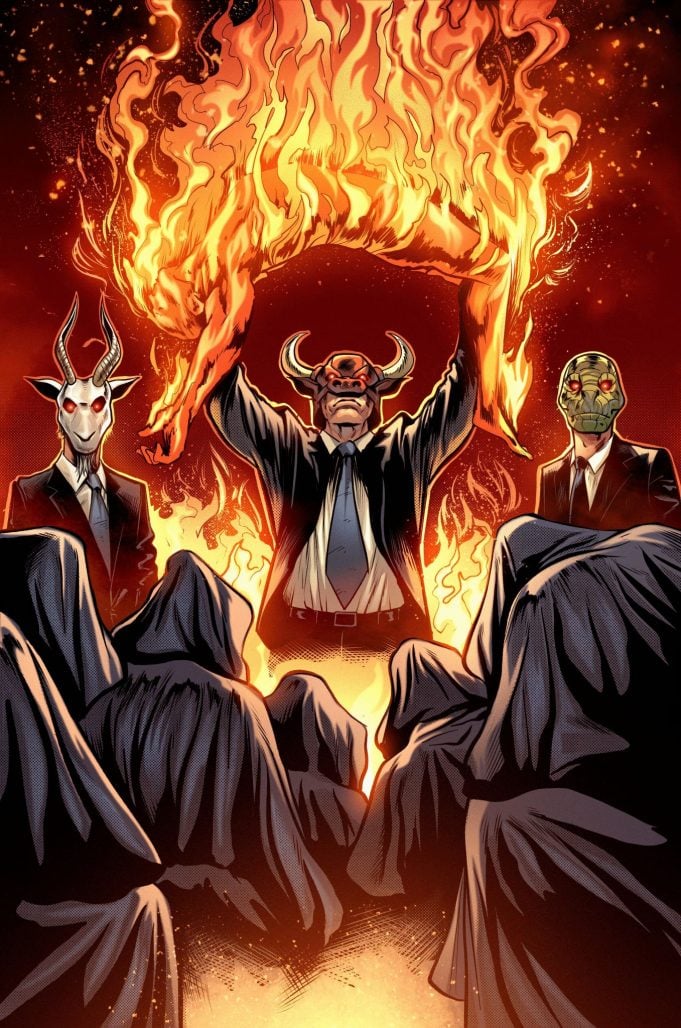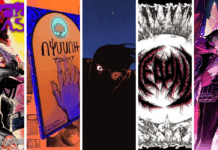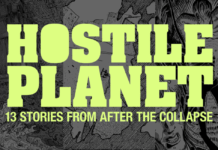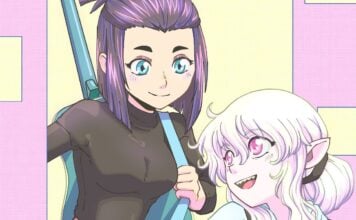What happens when Jewish mysticism meets modern comics? For writer Jeff Marvin (Cycles End, Grave Soldiers: Crutch Brigade), the answer lies in Hunters of Sheydim, a supernatural saga, from Golem Press, rooted in Kabbalistic lore that follows twin demon hunters, Caterina and Lucia, as they battle the Sheydim — creatures drawn from apocryphal texts and rabbinic myth — while grappling with questions of faith, identity, and destiny. Currently crowdfunding on Kickstarter, Hunters of Sheydim is intended to be an epic 12-issue saga merging apocalyptic horror, ancient mysticism, and brutal emotional stakes, written by Marvin, with the creative help of artist Riley Brown (Dead Acre: Black Badge), colorist Vinicius Townsend (G.I. Joe, Vampirella), and letterers Dezi Sienty (Teen Titans, Deathshroud) and Sinisa Matic (Deathshroud), and with editorial direction by Ori Ayalon and historical consultation by Rabbinit Dr. Tamar Marvin.
Although the demon-slayer genre is already crowded — from Buffy Summers (Buffy the Vampire Slayer) to Jentry Chau (Jentry Chau vs. The Underworld), Tanjiro Kamado (Demon Slayer), and even the Winchester brothers (Supernatural) — Hunters of Sheydim‘s demon-slaying sisters stand apart. Their story isn’t built on the Christian mythology that heavily influences many demon hunter stories in mainstream media and popular culture; instead, it draws from Jewish mystical traditions, often “experienced, passed down, and hidden in symbols and rituals that carry enormous meaning.”
The Beat sat down with Marvin to discuss Hunters of Sheydim‘s ancient inspirations, how his creative team brought the world to life, and what this project brings to the demon-hunter fiction genre that sets it apart from other demon-hunter stories.
OLLIE KAPLAN: Could you tell me more about how Jewish mysticism influenced Hunters of Sheydim?
JEFF MARVIN: You know, when I was younger, I remember Leonard Nimoy talking about how he built the mythology around Spock and the Vulcan people. A lot of it actually came from Judaism — even the “Live Long and Prosper” gesture is based on a Hebrew blessing that forms the letter Shin. Nimoy once said that as a kid, watching the adults make that sign in the synagogue felt almost magical — like he was witnessing a secret ceremony.
That idea really stuck with me. Jewish mysticism, especially in Kabbalah, has that same kind of quiet mystery. It’s ancient — it predates Christianity and Islam — but it’s also deeply private. It isn’t something that’s preached loudly; it’s experienced, passed down, and hidden in symbols and rituals that carry enormous meaning.
In Hunters of Sheydim, I wanted to bring that sense of the sacred and the secret into the story. When Caterina and Lucia say prayers or invoke divine names to fight demons, it’s not just superstition — it’s the continuation of a spiritual lineage that connects them to their ancestors. Those ancient traditions become their literal power against the Sheydim. It’s that blend of faith, history, and mysticism that makes the world of Hunters of Sheydim feel alive and rooted in something real.
KAPLAN: What is unique about telling a demon hunter story through the lens of Jewish mysticism?
MARVIN: When you think about a demon-hunter story through a Jewish mystical lens, what makes it unique is that you don’t see it a lot. There are plenty of supernatural tales, exorcism stories, angelic battles—but few framed specifically in Jewish mysticism.
In the rabbinic era — the time of the Sages — Jews did engage with demons, mystical beings, and exorcisms. But today those stories aren’t at the forefront of modern Jewish culture. So, placing hunters, demons, and old rituals in a Jewish-mystical framework gives you something quite fresh.
Also, the text of The Book of Enoch (and the wider apocryphal literature) touches on angelic and demonic realms with a very specific Jewish-rooted architecture: “Shamayim” (heavens), “Gehinnom” (underworld), and so on. That vocabulary and worldview aren’t simply borrowed for effect — it’s part of a tradition.
Compared to many pop-culture stories of demons like Azazel, Moloch, or Asmodeus — often filtered through a Christian horror lens as purely evil—Jewish tradition allows for ambiguity, complexity, and even cooperation in some stories. For example, Asmodeus (Ashmedai in Aramaic) appears in Jewish legend as a demon-king and adversary of Solomon, but also shows up in tales where he is entertaining, even morally ambivalent.
In Hunters of Sheydim, I draw on that ambiguity. The demons aren’t always black-and-white evil. The hunters don’t just fight faceless monsters. They engage a tradition of power, lineage, ritual, and history. That choice gives the story emotional weight, a sense of legacy, connection, and mystery that draws on Jewish mysticism rather than just the standard demon-slayer trope.
KAPLAN: What kinds of themes or questions does Hunters of Sheydim explore beneath the surface?
MARVIN: Beneath all the action and mythology, Hunters of Sheydim is really about what it means to wrestle with your own inner demons.
Our heroes fight monsters, yes — but they’re also confronting guilt, doubt, and the weight of destiny. In a lot of Jewish mystical stories, guilt itself almost feels like a living thing — something that can shape you, even make you sick. And in older folklore, that feeling was often personified as a Dybbuk — a restless spirit that clings to you, feeding off your sorrow or shame. I love that image, because it blurs the line between the spiritual and the psychological — which is what this series does all the time.
Another big theme is free will versus fate. The world of Hunters of Sheydim is full of visions and prophecies, but the real question is, “Can you change what’s been foretold? And if you can, do you make things better… or worse?”
For Caterina, that’s deeply personal. She’s faithful, disciplined, she believes in her mission — but as she learns more about her past, she begins to question whether she’s fighting her own war or one that was chosen for her. Lucia’s the opposite — she loves the fight, she thrives on it — but she struggles with belief. She doesn’t always know what she’s fighting for, and that uncertainty can be just as dangerous as any demon.
At its core, the series is about the human side of the supernatural — the idea that sometimes the hardest battles aren’t the ones you fight with a sword, but the ones you fight with your soul.
KAPLAN: What cultural and historical research was involved in bringing this story to life?
MARVIN: A lot of research went into Hunters of Sheydim. I’ve read sections of the Book of Enoch, parts of the Talmud, and I even tried to make my way through the Zohar, which, if you’ve ever opened it, you know is pretty trippy. It’s dense and mystical, but it gives you this incredible window into how Jewish mysticism frames the universe.
I’ve also drawn from folklore — stories like The Golem of Prague — that blend faith, magic, and moral questions about creation and control. Those old legends are a huge influence on the tone and spiritual architecture of the series.
But honestly, one of my biggest resources is my wife, Tamar. She has a PhD in Medieval Judaism, and she’s also an ordained Rabbi. She’s been instrumental in grounding some of my more… let’s say, “creative” interpretations. Whenever I go too far off the reservation, she’s the one who brings me back. Having her perspective helps keep the story authentic — it makes sure that the Jewish voice in Hunters of Sheydim feels both respectful and real.
KAPLAN: Can you tell me more about your personal history with comic books? Why are you attracted to telling stories through the medium of comic books?
MARVIN: I’ve loved comics for as long as I can remember. I started reading when I was about five — my first love was Spider-Man. In the ’80s and ’90s, there were so many Spidey books, and I devoured all of them. From there, I branched out — Green Lantern, Batman, Wolverine — and as I got older, I discovered writers like Alan Moore, Neil Gaiman, J. Michael Straczynski, and Jeph Loeb. Those creators showed me that comics could be literary, emotional, even philosophical.
When I started making my own books, I realized how much comics have in common with film. I studied film originally, and both are intensely collaborative mediums — you can’t do them alone. There’s nothing quite like handing a script to an artist and then seeing them come back with something that completely surprises you — something better, richer, more alive than what you imagined. That collaboration always gives me a rush.
I’ve always thought of comics as one of the oldest storytelling languages — after oral tradition, they’re really the first visual narrative. Humanity’s been drawing stories on walls since the dawn of civilization. That idea even inspired the name of my first company, Cave Drawing Ink.
And as a Jewish creator, I feel connected to the legacy of comics as a medium shaped by Jewish immigrants — people who came to New York, built new lives, and created an art form that changed the world. Carrying that tradition forward, telling stories through this visual language — it’s exciting, it’s meaningful, and honestly, it still feels like magic to me.
KAPLAN: How did you assemble your creative team (artist, colorist, letterer, etc.)? And what is your collaborative process like with them?
MARVIN: I consider myself really lucky. Over the last twenty years or so, I’ve been able to build and keep a core group of incredibly talented veterans close by — people who’ve become not just collaborators, but friends.
My editor, Ori Aylon, has been my creative compass from the start. He gives me that tough-love feedback that every writer needs, and he was instrumental in helping me find the right artist for this story — and that turned out to be R.D. (Riley) Brown. Riley’s got this amazing, realistic, almost cinematic style that perfectly fits the tone of Hunters of Sheydim. Early on, he wasn’t deeply familiar with Jewish culture, but he learned fast. He started adding all these authentic details — kippot, tichels, mezuzahs — things that grounded the world and made it feel lived-in. And his work on the scenes inspired by Ezekiel — the chaos and wonder of Shamayim — was just breathtaking.
Then there’s Vinicius Townsend, our colorist, who took Riley’s pencils and just electrified them. His palette gives Shamayim this depth and vibrancy that leaps off the page — every panel feels alive.
On lettering, Dezi Sienty and Sinisa Matic are absolute pros. I’m the first to admit — I can be a little talky sometimes — but they make it all sing. They find the rhythm, the flow, the breathing room. They give the dialogue its voice.
It’s been a real joy creating Hunters of Sheydim with this team — each of them brought something unique that elevated the book beyond anything I could’ve imagined.
KAPLAN: You state on the book’s Kickstarter campaign page that Hunters of Sheydim is the first step towards a larger universe. Where do you see the story evolving from here? What do you hope is next for Hunters of Sheydim after the crowdfunding campaign ends?
MARVIN: I tend to think of this first book as book one of four — together they form what I’d call the first “season” of Hunters of Sheydim. There’s a much larger story at play, and this book is really just the beginning.
Right now, most of the action takes place in Europe and Israel — it’s very rooted in Jewish history and mysticism. But as the series evolves, I want to expand that world and explore demons, lore, and mythology from other cultures and faith traditions as well.
In later arcs, we’ll move to America, where the team will encounter entirely new Sheydim and new forms of belief — and eventually, we’ll take them all the way to Japan. That’s where things get really interesting, because they’ll be fighting in unfamiliar territory, dealing with unknown forces, and facing challenges that push them completely out of their comfort zone.
One of my favorite things about where the story is heading is the idea of a global network of hunters — people from different backgrounds, each with their own traditions and ways of fighting evil. The twins will have to learn to adapt, to collaborate, and to understand that this war against darkness is much bigger than any one faith or culture.
So when I say Hunters of Sheydim is the first step toward a larger universe — I really mean that. My hope after the Kickstarter is to keep building that world, one story, one culture, one demon at a time.
KAPLAN: What kind of perks or rewards can backers look forward to?
MARVIN: We’ve put together some really fun rewards for Hunters of Sheydim. One-Sheets are featuring some of our most striking pages — like the big Shamayim splash page — and of course, the main cover art, which looks incredible as a standalone print.
We’ve also got T-shirts, a really cool Golem mug, and probably the item I’m most proud of — our Chemosh Demon Plushie. It’s about nine inches tall, a little cuter than the actual Chemosh you’d meet in the book, but every plush comes with a certificate of appreciation that includes the demon’s name and a short bio of who they were before they became a Chemosh. We even made a Kickstarter-exclusive green variant — that one’s limited, with its own certificate, so if you want it, you’ll want to grab it fast.
We also have an exclusive variant cover by the amazing Guilherme Balbi, which is a limited-tier tier and is already getting a lot of attention from collectors.
And to make things even more exciting, once we hit $10,000, every backer who purchased a book — whether the main cover or the variant — will automatically get the upgraded foil-stamped title at no extra cost. Plus, we might have a few surprise tiers along the way. So whether you’re into limited art, collectibles, or just love supporting indie comics, there’s something really special waiting for everyone who joins the hunt.

KAPLAN: Is there anything else that you would like to add?
MARVIN: I think one of the most personal aspects of this story — something I haven’t really talked about as much — is the idea of belonging. What does it mean to discover that you’re part of something you never realized you were destined to be part of?
That question hits very close to home for me. I came to my Jewish faith later in life, and that journey mirrors what Caterina and Lucia go through in Hunters of Sheydim. They grow up believing they’re Catholic, only to uncover that their family was actually Conversos — Jews who were forced to convert during the Spanish Inquisition.
Like them, I’ve felt that sense of imposter syndrome — that question of, “Do I really belong to this history, this faith, this people, if I didn’t grow up inside it?” And that tension — between heritage, identity, and acceptance — hangs over the whole story.
At its core, Hunters of Sheydim isn’t just about fighting demons. It’s about unlocking a part of yourself you didn’t know was there, and learning what it truly means to be Jewish — culturally, spiritually, and personally.
And that’s what I hope readers take away from it. I want people to read it, talk about it, and find their own connection to it — because, to me, the best part of any great story, whether it’s a comic or a film, is the conversation that happens afterward.
Hunters of Sheydim is currently funding on Kickstarter and launches from Golem Press on January 21, 2026, with preorders opening soon. Visit golem-press.com or follow @golempress on socials for updates.













